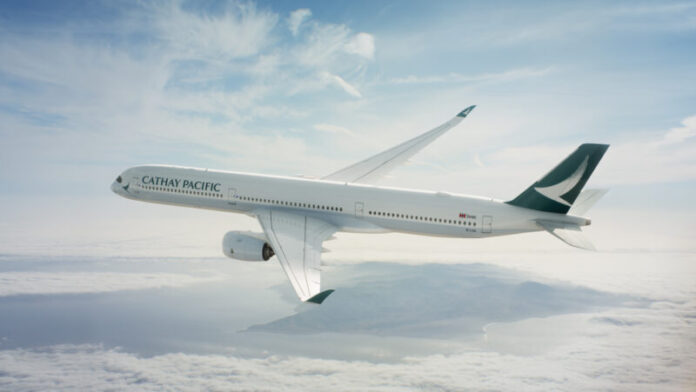
-
Hong Kong’s flag carrier says its HK$6.55 billion loss in 2022 mostly incurred by associates in China
-
Cargo revenue fell over 16% in 2022, but passenger revenue tripled to over HK$13 billion as the Hong Kong government gradually eased Covid restrictions
-
Cathay saw light at the end of the tunnel in H1 2022 and the positive momentum has continued into 2023
Cathay Pacific reported a loss of HK$6.55 billion (US$830 million) in 2022, its third year of deficit, after China assets took hits that weighed down an otherwise markedly improved performance by Hong Kong’s flag carrier and its other airlines in the second half.
Losses grew from HK$5.5 billion in 2021 mainly due to setbacks suffered by mainland associates including Air China and Air China Cargo, the airline said in a filing on the Hong Kong stock exchange on March 8.
China had closed its borders for much of last year after a wave of the COVID-19 Omicron variant spread across the country, forcing months-long lockdowns in several cities that brought economic activity to a minimum.
For the third consecutive year, no dividend was announced for Cathay Pacific shareholders, who, instead, took a HK$1.113 loss per share, larger than the HK$0.95 loss in 2021.
The airline said cargo revenue fell more than 16% last year, but its passenger revenue tripled to over HK$13 billion as the government gradually eased COVID restrictions, enabling it to carry 2.8 million passengers in 2022. That was nearly four times the number in 2021.
RELATED READ: Cathay’s November passenger traffic up 652%
Chief executive Ronald Lam, who succeeded Augustus Tang early this year, said Cathay saw light at the end of the tunnel in the second half of 2022, with the positive momentum continuing into 2023.
“After three brutal years of the Covid-19 pandemic, we have finally entered into a new exciting phase, in which we will rebuild Cathay Pacific for Hong Kong,” Lam said.
“So far this year, we have seen very strong demand for our flights. Whether this will continue into the latter half of this year is yet to be seen. But judging on the booking trends for the first half of the year, we are very positive about the outlook.”
Cathay chairman Patrick Healy said the group’s two airlines, Cathay Pacific and HK Express, will be able to operate at about 70% of their pre-pandemic flight capacity by the end of this year. He said the two carriers should reach full levels in 2024.
Healy said the second-half results for Cathay and its subsidiaries improved markedly over the first-half results, producing a profit of HK$2.26 billion in the second half, but took a loss of HK$255 million for the full year.
Lam said Cathay’s travel and cargo operations in 2022 were constrained by travel restrictions and quarantine requirements for both travelers and Hong Kong-based aircrew that were in place until the government progressively adjusted the curbs from May 1 onwards.
“These adjustments enabled us to gradually resume more flights, especially between October and December. On the travel side, across Cathay Pacific and HK Express, we added about 3,000 passenger flights during the fourth quarter of 2022,” Lam said.
By December, the Cathay group was operating about one-third of its pre-pandemic passenger flight capacity, around 8 times the average capacity the two airlines together operated in the first half of 2022.
At the close of the year, Cathay Pacific had operated passenger flights to 58 destinations, double the 29 it flew to in January 2022.
RELATED READ: Cathay passenger traffic up 306% in July
Cathay’s passenger revenue in 2022 soared 214.9% year on year to HK$13.69 billion. Passenger flight capacity, measured in available seat kilometers (ASKs) increased 51.6%, while traffic, measured in revenue passenger kilometers (RPKs), shot up 258.3%.
Lam said Cathay resumed operating a full freighter schedule in August. As Cathay added more passenger flights, the additional belly capacity provided by its passenger aircraft enabled the airline to offer more options to its cargo customers.
By the end of 2022, Cathay was operating about two-thirds of its pre-pandemic cargo flight capacity levels, he said.
Cargo revenue in 2022 fell 16.6% y-o-y to HK$26.99 billion. Capacity, measured in available cargo ton kilometers (AFTKs), decreased 19.0% mainly due to pared cargo capacity, particularly in the first part of the year, amid tightened COVID-19 crew quarantine restrictions.
Traffic, measured in cargo revenue ton kilometers (RFTKs), slipped 29.8%. Total tonnage fell 13.4% to 1.15 million tons. Load factor was 70.6% compared with 81.4% in 2021, and yield increased 18.5% to HK$4.67.
Lam said that after the past few challenging years, Cathay is moving into a new phase.
“Our focus is now firmly on rebuilding Cathay Pacific for Hong Kong. We are reconnecting Cathay Pacific with Hong Kong, as well as reconnecting Hong Kong with the world,” Lam said.




